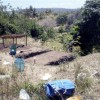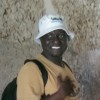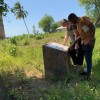Blogu hii itaandikwa kwa kutumia lugha za Kiswahili na Kiingereza. This blog is written in Swahili and English.
This blog was written by UDSM Masters student Joyce Mreta and media co-ordinator Katrina Foxton from York, about the experiences of the heritage team in conducting focus group interviews with community groups in Kilwa. These formal conversations (alongside other conversations with the Antiquities Department and Kilwa Island Tour Guides) were vital in informing the output for the fieldschool! Read on for more information:
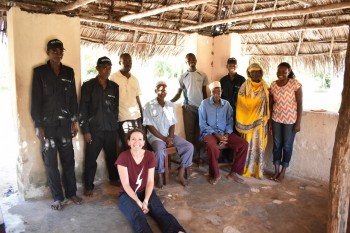
Figure One. The community elders and security staff at Songa Mnara, along with York team leader Dr Stephanie Wynne- Jones and UDSM student Joyce Mreta. (Photo credit Ashley Fisher) (CLICK TO ENLARGE)
UTANGULIZI- nini maana ya Mjadala wa kikundi?
Katika Wiki ya pili ya mradi wa CONCH unaofanyika Kilwa, tuliamua kuchunguza na kuchukua maoni ya watu wanaofanya kazi na wanaoishi katika eneo linalozunguka urithi wa Kilwa. Lengo ni kusaidia kutengeneza kipeperushi kipya kama tulivyoombwa na wafanyakazi wa idara ya mambo ya kale na waongoza watalii.
Timu iliunda mjadala wa kikundi na kuchukua maoni mbalimbali. Lakini unaweza kuuliza nini maana ya mjadala wa kikundi?
Mjadala wa kikundi ni maswali yanayohusu ubora ambayo yanajumuisha kati ya watu 6-12 ambapo mtafiti anauliza maswali. Pia anakuwa na mawazo kadhaa ya kuuliza watu tofauti .
Introducing focus group interviews
During the second week of the CONCH project in Kilwa we explored the opinions of the people working on and living next to the heritage of Kilwa. Our aim was to create meaningful resources for these various individuals, in particular a new brochure, which was requested by the Antiquities staff and the local tour guides.
The team led ‘focus groups’ to capture different viewpoints in relation to our design of the brochure. But what is a focus group you may ask?
A focus group is a form of qualitative interviewing which usually involves between 6-12 participants, who are guided in conversation by the researcher, using a series of questions as prompts. We had several key ideas about what to converse about and we created themes and specific questions to explore these ideas (see below).
Tuliongea na nani?
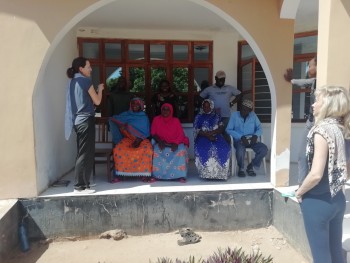
Figure 2. Community elders from Kilwa Kisiwani with York team leaders Dr Stephanie Wynne-Jones and Dr Sara Perry, and UDSM students Sinyati Robinson and Noel Fidelassway. (Photo credit Katrina Foxton) (CLICK TO ENLARGE)
Kutoka Kilwa Kisiwani tuliongea na :
Mwenyekiti wa kijiji, mwenyekiti wa kamati ya magofu, na wazee wengine jumla walikuwa sita:
- Asha Abdallah Kabona
- Asha Mzee Ismail
- Mzee Saidi
- Mwajuma Mbarawa Chande
- Ahmed Mawe
- Mzee Said Hamis (katiba magofu)
Kutoka Songo Mnara walihusishwa;
- Yahaya Mohamed (katiba magofu)
- Mohamed Yahaya Juma (mkazi wa ndani)
- Said Amri Said (mlinzi)
- Rajabu Masudi (mkazi wa ndani - kike)
- Hassan Yusuph Kessy (mlinzi)
- Ally Juma (mkazi wa ndani)
- Masood Mohamed Hamis (mkazi wa ndani)
Idara ya Mambo Kale:
- Mercy Exson Mbogelah - Meneja wa Tovuti
- Idiphonce Mlowoka - Mtaalam wa Uhifadhi Msaidizi
- Mohamedi Rahama - Mtoaji Msaidizi
Kutoka kikundi cha waongoza watalii (Kilwa Island Tours):-
Watembeza wageni na meneja kutoka kilwa masoko (Abdullah Ahmed & Samuel Ahmed)
Who did we speak to?
From Kilwa Kisiwani:
Chairman of the village; Chairman of village ruins committee; four members of the committee. These were:
- Asha Abdallah Kabona
- Asha Mzee Ismail
- Mzee Saidi
- Mwajuma Mbarawa Chande
- Ahmed Mawe
- Mzee Said Hamis (chairman of Kilwa Kisiwani Ruins Committee)
From Songo Mnara:
- Yahaya Mohamed (ruins chairman)
- Mohamed Yahaya Juma (local resident)
- Said Amri Said (security guard)
- Rajabu Masudi (local resident - female)
- Hassan Yusuph Kessy (security guard)
- Ally Juma (local resident)
Masood Mohamed Hamis (local resident)
From Antiquities Division, Kilwa
- Mercy Exson Mbogelah - Site Manager
- Idiphonce Mlowoka - Assistant Conservation technician
- Mohamedi Rahama - Assistant Conservator
From Kilwa Island Tours
5 Tour guides and 2 managers (Abdullah Ahmed & Samuel Ahmed, both male) from the office at Kilwa Masoko
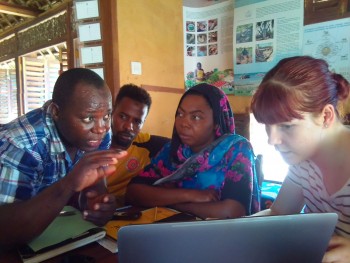
Figure 3. Kilwa Tour Guides informing student Elena Murray regarding their social media use. (Photo credit Ashley Fisher) (CLICK TO ENLARGE)
Maswali gani tuliuliza?
Maeneo ya maswali kwa wakazi na walinzi yanahusiana na :
-
Umuhimu wa magofu kwenu ( magofu gani yanaumuhimu kwenu)
-
Mahusiano yao na magofu katika maisha ya kila siku
-
Mahusiano na wageni ( namna wanavyopenda kishirikiana na wageni)
-
ujuzi/ uzoefu katika magofu na historia ya archiolojia kama wanajua na kama wanapenda kujua zaidi.
What questions did we ask?
The themes of our questions to the community members and security guards related to:
-
the importance of the ruins to them (i.e. what did they consider to be the most significant ruin to them?)
-
their interaction with the ruins day-to-day
-
their interactions with visitors (or how they wished to interact with them)
-
their knowledge about the ruins and any archaeological stories they knew about/ what they’d like know more about in terms of archaeological research on the site
Questions to the Antiquities staff were slightly different, primarily based on their roles and their views about the various sites. In addition with the local Kilwa tours guides we discussed their thoughts on Kilwa's islands touristic needs: this was a separate discussion focused on social media training but some of the content was useful for our later design. Below we focus on our conversations specifically with representatives from Kisiwani and Songo Mnara, as we wanted to consider these communities' views especially.
Matokeo ya utafiti / What did we find?
Baada ya kuuliza maswali, tumepata majibu tofauti kwa kila mmoja. ( kundi moja lilikuwa na washiriki watatu na kundi lingine lilikuwa na washiriki wawili).
Mwanaume mmoja alisema watu wa Kilwa Kisiwani wanajivunia kuwa na magofu. kwake Msikiti mkuu ni muhimu kwa ajili ya elimu mwingine alisema anapenda Husuni kubwa kwa jinsi lilivyojengwa kwa ufanisi mkubwa, mwanamke alisema gereza kwake ni muhimu kwasababu uso wa mbele unavutia wageni wanapokuja. Makundi yote yalisema yanatumika kwa kufundishia na matambiko (japokuwa sio kila siku) lakini hasa kwenye msikiti pamoja na makaburi wanajivunia kuwa na magofu.
After asking an icebreaker question, we found that the community groups from Kisiwani (who we split into one group of three & one group of two) answered only slightly differently from each other.
One man felt that the Great Mosque was important to community education. Another said he loved Husuni Kubwa (the Great Palace) for its architecture, and one woman said the Gereza (Portugese fort) was the most important as the ‘face’ of the island which visitors could see on arrival. In both groups their interaction with the site (not necessarily day-to-day) was mainly educational and spiritual - particularly at the graveyard and at the Great Mosque. They also have a sense of pride for the ruins (e.g., by clearing litter and showing the ruins to family visitors).
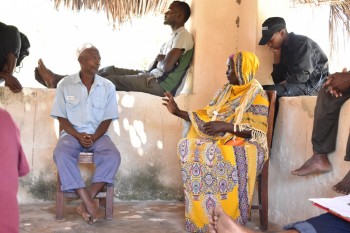
Figure 4. Community elders discussing aspects of the Songo Mnara site (Photo credit Ashley Fisher) (CLICK TO ENLARGE)
Makundi yote walitoa taarifa kuwa mahusiano na wageni yapo kidogo wakati mwingine hakuna (ambapo wanaletwa na waongoza watalii) Hata hivyo, wakaazi wa kilwa kisiwani wameonyesha shauku kubwa na kuwakaribisha wageni katika kisiwa, kujifunza ujuzi na desturi, kuwashauri juu ya kutumia miondombinu iliyopo na namna sahihi ya kuishi uwapo kisiwani ( mfano kuvaa kwa heshima, na kuvua viatu ufikapo kwenye baadhi ya misikiti).
Both groups reported little or no interaction with visitors (who are usually led by tour guides). However, the Kisiwani community group also showed great interest in welcoming visitors to the island, to share their knowledge and customs, to advise them on the use of facilities and how to act appropriately on site (for example, wearing appropriate clothing and taking off shoes at the different mosques).
Songo Mnara , kuna mahusiano madogo kati ya wageni na wenyeji. Wanapendelea wageni kujinza desturi zao, na kuwashauri wageni namna nzuri ya kukaa kwa usahihi (mfano, usichukue picha bila ruhusa zao). Wanamahusiano kidogo na magofu ukilinganisha na magofu ya kilwa kisiwani lakini pia wanatoa sadaka kwenye msikiti wa makaburi na kujisikia magofu ni mazuri.
At Songo Mnara, again very little interaction with the visitors was reported. They also wanted to share their customs, and to advise visitors how to act appropriately (for example, to not take photos of villagers or village buildings and homes without the villagers’ consent). There was a less strong connection with the ruins as there has been a lot of immigration to the island since the town was abandoned and because the village is located some distance from the site itself. But do they leave offerings by the funerary mosque and also feel some of the ruins are beautiful.
Asilima ndogo ya wakazi kati ya Kilwa kisiwani na Songo Mnara wanauelewa mdogo na Asilimia nyingine hawana kabisa uelewa kuhusu historia ya eneo, Asilimia ndogo wanauelewa kuhusu archaeology excavation ila wanapendelea kupata taarifa kupitia kitabu cha historia iliyoandikwa kwa lugha ya kiswahili.
At both Kisiwani & Songo Mnara, focus group participants reported that they had little or no knowledge of the history of the site, and very little knowledge about the archaeological excavations. Both groups wished for more information (for example, a book on the history in Swahili).
Wafanyakazi wameeleza kuwa panahitajika zaidi uelewa kuhusu eneo la urithi .Pia ameainisha kuna umuhimu wa vifaa vya kufundishia kama (filamu) ambavyo vitaonyesha kwa wageni na wenyeji.
The staff views revealed to us that additional knowledge about the sites was required. They highlighted the need for better signage and educational tools (such as films) which can be shown to both visitors and local groups. The need for further educational tools, advertising, and in addition, the expansion of touristic activities (i.e. package holidays) was raised by the Kilwa tour guides when we spoke to them separately.
Changamoto na Matarajio
Changamoto kwa jamii zote zilikuwa dhahiri. Inahitajika mwingiliano kati ya wageni na wenyeji na ufahamu juu ya historia ya eneo. Ukweli ni kwamba ufahamu juu ya eneo la urithi linapita kwa njia ya masimulizi. (licha ya utafiti mwingi uliofanywa) ulikuwa tatizo na suluhisho. Ambazo tunatarajia kuchangia siku zijazo.
Kwa Kulingana na changamoto za mbinu za kiutafiti hasa jinsi ya kuongoza vikundi vya majadiliano, popote pale, ni kwamba baadhi yaliyopita kuhusu usaili wa maelezo kwa ujumla yaliyoongozwa na (Sara Perry) tulitafakari ugumu katika kuwakilisha sauti za watu wote kupitia mbinu hii. Ingawa tulibaini ugumu huu, baada ya usaili kwisha , wanachuo wa Chuo Kikuu cha Dar es Salaam. Walishauri kuwa tumepata taarifa za kina kuhusiana namichakato ya kijamii ihusuyo kikundi. Hii itatuwezesha kuweka vizuri ruwaza ya kipeperushi ili iweze kuingiza mambo yote ambayo hayakutajwa pia vitu vyote vya thamani vilivyoainishwa na waathirika wakubwa wa akiolojia na utalii katika eneo la Kilwa. Kwa siku za baadaye, blogu hii itaweka wazi matokeo ya mashauriano haya.
Challenges & Going forward
The challenges for both communities are obvious: more interaction with visitors and more insight into the history of the sites is required. The fact that most knowledge about the site is passed via oral tradition only (despite the wealth of research carried out) is clearly a problem, and the obvious solution (i.e. more accessible information) is one that we hope we can contribute to in the future.
In terms of the methodological challenges in leading these focus groups, as with all such groups, some people spoke more than others. Through previous discussion about qualitative interviewing generally (led by Sara Perry) , we had already reflected on the difficulty in representing all voices using this method. Despite noting this difficulty after the interviews were over, the UDSM students suggested we’d gained relatively in depth information, considering the social dynamics of the group. This would enable us to forward with the design of our brochures so that they can attend to the uncovered issues and values identified by those who are most affected by the archaeology and tourism in the Kilwa region. A future blog post will uncover the end result of these consultations!

